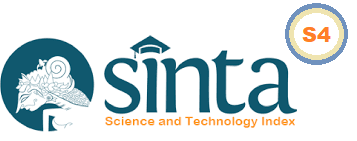Analysis of Boosting Engine Torque and Horsepower via Diffuser Installation on the Exhaust Pipe
Abstract
References
[1] Badan Pusat Statistik, “Perkembangan Jumlah Kendaraan Bermotor Menurut Jenis (Unit), 2018-2020 ,” https://www.bps.go.id/indicator/17/57/1/jumlah-kendaraan-bermotor.html.
[2] S. Wang, J. Abbas, M. S. Sial, S. Álvarez-Otero, and L. I. Cioca, “Achieving green inNVOation and sustainable development goals through green knowledge management: Moderating role of organizational green culture,” Journal of InNVOation and Knowledge, vol. 7, no. 4, Oct. 2022, doi: 10.1016/j.jik.2022.100272.
[3] A. Wyns and J. Beagley, “COP26 and beyond: long-term climate strategies are key to safeguard health and equity,” The Lancet Planetary Health, vol. 5, no. 11. Elsevier B.V., pp. e752–e754, NVO. 01, 2021. doi: 10.1016/S2542-5196(21)00294-1.
[4] D. Silva Cardoso, P. Oliveira Fael, and A. Espírito-Santo, “Instantaneous angular velocity and torque on Otto single-cylinder engine: A theoretical and experimental analysis,” Energy Reports, vol. 6, pp. 43–48, Dec. 2020, doi: 10.1016/j.egyr.2020.10.031.
[5] W. Arismunandar, Penggerak Mula Motor Bakar Torak. Bandung: ITB PRESS, 1988.
[6] F. Salek, M. Babaie, M. M. Naserian, and M. H. Ahmadi, “Power enhancement of a turbo-charged industrial diesel engine by using of a waste heat recovery system based on inverted Brayton and organic Rankine cycles,” Fuel, vol. 322, Aug. 2022, doi: 10.1016/j.fuel.2022.124036.
[7] M. Szwaja, M. Chwist, A. Szymanek, and S. Szwaja, “Pyrolysis oil blended n-butanol as a fuel for power generation by an internal combustion engine,” Energy, vol. 261, Dec. 2022, doi: 10.1016/j.energy.2022.125339.
[8] N. E. Efi et al., “Valve Lift Overlapping Effect by Analyzing Engine Charge Flow in Various Cam Profiles for on Modenas CT115s using CFD Simulation,” in IOP Conference Series: Materials Science and Engineering, NVO. 2018, vol. 429, no. 1. doi: 10.1088/1757-899X/429/1/012054.
[9] J. Hunicz, M. Mikulski, M. S. Geca, and A. Rybak, “An applicable approach to mitigate pressure rise rate in an HCCI engine with negative valve overlap,” Appl Energy, vol. 257, Jan. 2020, doi: 10.1016/j.apenergy.2019.114018.
[10] Z. Ahmad, O. Kaario, C. Qiang, and M. Larmi, “Effect of negative valve overlap in a heavy-duty methanol-diesel dual-fuel engine: A pathway to improve efficiency,” Fuel, vol. 317, Jun. 2022, doi: 10.1016/j.fuel.2022.123522.
[11] S. Kimura, A. Takeshita, Y. Yamasaki, M. Muto, T. Hikita, and T. Fujii, “Model-based control of HCCI engine with negative valve overlap considering engine speed,” in IFAC-PapersOnLine, 2021, vol. 54, no. 10, pp. 15–20. doi: 10.1016/j.ifacol.2021.10.134.
[12] B. Sahin A’, A. J. Ward-Smith, and D. Lane, “The pressure drop and flow characteristics of wide-angle screened diffusers of large area ratio,” 1995.
[13] J. Anggaputra and S. Hernowo, “Pengaruh Ukuran Diffuser Terhadap Laju Aliran Di Dalam Ruang Uji Terowongan Angin,” Jurnal Voering, vol. 7, no. 1, pp. 9–15, 2022, doi: https://doi.org/10.32531/jvoe.v7i1.483.
[14] T. Mara, E. Sabah Shukri Askari, and W. Wisnoe, “"Universiti Pressure Drop and Flow Characteristics in a Diffuser with a Dimpled Tube,” Journal of Mechanical Engineering, vol. 18, no. 2, pp. 125–144, 2021.
[15] X. Hu, R. Zhang, J. Ye, X. Yan, and Z. Zhao, “Influence of different diffuser angle on Sedan’s aerodynamic characteristics,” in Physics Procedia, 2011, vol. 22, pp. 239–245. doi: 10.1016/j.phpro.2011.11.038.
[16] “Parametric Investigation of Effect of Diffuser Angle on the Flow Characteristics of an Ahmed Body Akash MB Pranjal Patil Tej Pratap Singh.” [Online]. Available: www.ijert.orgDOI: 10.30595/cerie.v3i1.15429
DOI (PDF): http://dx.doi.org/10.30595/cerie.v3i1.15429.g5577
Refbacks
- There are currently no refbacks.

This work is licensed under a Creative Commons Attribution 4.0 International License.
ISSN: 2774-8006














